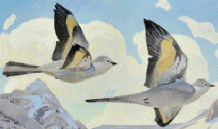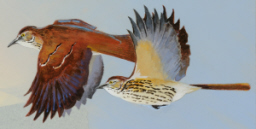Long-Billed Curlew
A two-foot bird with a three-foot wingspan, an outlandish down-curved, sickle-shaped bill, flashing dark cinnamon under wings and piercing cries commands attention.
Long-billed curlews are shorebirds that prefer to breed on dry open prairies in their remaining habitat in the interior American West, albeit often close to a pond or watercourse. Even in winter — although many long-billed curlews migrate to seashores, salt marshes and mudflats — most prefer fields and prairie.
Despite the long-billed curlew’s large size (it is the largest of North American shorebirds), its overall yellowish-brown plumage helps camouflage the bird even when in open terrain. Detection, however, is at times easy; long-billed curlews are noisy birds. Their calls are variously interpreted as piercing, plaintive, musical, fluting, delightful. Always loud.
A characteristic rising and falling curl-e-e-e-u-u- call note has suggested its common name. There’s also a rapid kU-U-U-U and a rising cur-lee.
The long-billed curlew reaches a height of two feet on dark legs and sports a long, thin, down-curved bill that is dark at its droplet-shaped tip, shading to a flesh tone at its base. This crescent-shaped bill can be eight inches long.
Once abundant, the “sicklebill” is now uncommon. Around the turn of the last century, its large size, its easy decoying by imitating its calls, its unfortunate habit of attempting to investigate the cries of a wounded companion, and its palatability, led to its drastic decline. Overhunting, along with habitat loss as land was given over to agriculture, almost extirpated the species. Count yourself fortunate to see long-billed curlews in the wild.

